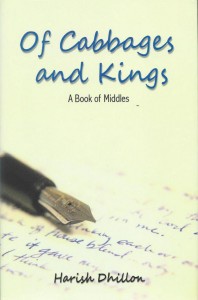Of Cabbages and Kings
by Harish Dhillon
Hay House.
Pages 243. Rs 299.
The sheer ordinariness of life, which most of us have to live, is enlivened by some events that provide the silver lining to the dreary clouds of routine which becomes our life. It could be an encounter with someone, the sight of something, triggering off an association that brings a smile on the face… anything that lifts our spirits.
 Newspapers, as first drafts of history, chronicle events, people and, pains of the poor, many things that we read every morning. These also equip us to handle the day. Page 3 and the peccadilloes of people famous for being famous may provide some amusement but for a real chuckle, many readers go to the pages largely associated with weighty comment, the Opinion or Editorial page. Nestled between serious opinion and people’s voices in the form of letters is the ‘middle’.
Newspapers, as first drafts of history, chronicle events, people and, pains of the poor, many things that we read every morning. These also equip us to handle the day. Page 3 and the peccadilloes of people famous for being famous may provide some amusement but for a real chuckle, many readers go to the pages largely associated with weighty comment, the Opinion or Editorial page. Nestled between serious opinion and people’s voices in the form of letters is the ‘middle’.
Vignettes can make for excellent middles, but only if the person who is narrating these has a command over the language, a sense of drama and an ability to convey his story in less than 500 words or so. It is seldom that this combination is to be found, and even then, it takes more than that to be a successful middle writer.
One of the names that often pops out of the pages of The Tribune is that of Harish Dhillon, who has shared many a story of his life with the readers of the paper. Through his numerous middles, we know of his life as a student and a teacher, later the Principal of his alma mater, The Lawrence School, Sanawar, as well as that of Yadavindra Public School, simultaneously and individually at the Patiala and Mohali campuses.
Dhillon is a versatile writer, with books ranging from Love Stories from Punjab to The First Sikh Spiritual Master. He recently wrote The Legend of Banda Bahadur and now we have his collection of middles. Many readers of The Tribune would be revisiting these. The writer acknowledges his debt to the paper that published his first middle in 2005. Since then, readers got a taste of the life that went on at The Wonderland that was Sanawar; shared the horror of a visit of The Unexpected Visitors at YPS, Patiala; learnt how special Gianiji and Tamatar were. Aunty Jaswant’s Story is an inspiring life-lesson. As we look at these lives, we realise the importance of there being a scribe who would place their lives in this perspective. We would have lost something important had we not known about them.
“She was aware of all my shortcomings, of all the mistakes that I have made over the years, but she remained always non-judgemental in her affecting, unswerving in her loyalty. She could brook no element of criticism as far as I was concerned,” a touching tribute to a student who became a colleague and a friend of the author. As you read The End of a Song, you feel a lump in your throat, even as you marvel at an intense relationship so delicately sketched.
Middles have sometimes been derided as I-stories, no, not the lower case ‘i’ that would make these trendy, but the upper case ‘I’ which makes these pedantic, pontificating and pretentious. The subjects of these middles wear the crown; the writer is the chronicler, of both felt and observed experiences.
Middles seldom have a life outside the pages of the newspaper these are published in. Dhillon acknowledges the help of his old students in getting the book printed when many publishers turned down the proposal on the grounds that such books do not sell. This book may prove them wrong, since the writer has an audience that may dip into the vignettes of lives presented in the book, to re-live memories, or relieve themselves of the tedium of life.
The review was published in The Tribune on March 30, 2014.
